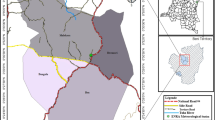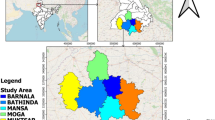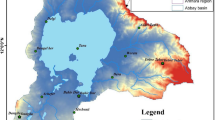Abstract
Trend analysis of rainfall is often carried out in water resources management to understand its distribution over a given region. The cumulative seasonal and annual rainfall derived from monthly datasets spanning 102 years (1901–2002) for 11 districts of the semi-arid Karnataka, India, was used for the trend analysis. The two-step homogeneous test approach was carried out on all the time series. Then, lag-1 autocorrelation was conducted only on homogeneous time series. Only 78.18 % of the total time series data were detected as homogeneous, and 95.35% of time series data were found to have insignificant autocorrelation. Then, the Innovative Trend Analysis (ITA) method was applied to 43 homogeneous rainfall time series, as well as to 41 time series using the MK and SR tests, and to two time series using the mMK test. The MK and SR tests detected a significant trend in 14.63% of the time series, while the ITA method was able to detect a trend in 93.02% of the total time series data. The MK and SR tests revealed significant trends in winter and post-monsoon season precipitation for two districts, but only for one district in the case of summer and annual rainfall. No trend was identified for monsoon season precipitation. The mMK test showed a positive trend for the post-monsoon season in a district, while the ITA method revealed significant trends for all seasons in most districts. The sub-trend analysis revealed trends that traditional methods were unable to detect.












Similar content being viewed by others
Data availability
The datasets generated during and/or analysed during the current study are available in the India water portal repository, http://www.indiawaterportal.org/metdata.
References
Abghari H, Tabari H, Hosseinzadeh Talaee P (2013) River flow trends in the west of Iran during the past 40years: impact of precipitation variability. Glob Planet Change 101:52–60. https://doi.org/10.1016/j.gloplacha.2012.12.003
Aher MC, Yadav SM (2021) Assessment of rainfall trend and variability of semi-arid regions of Upper and Middle Godavari basin, India. J Water Clim Chang 12:3992–4006. https://doi.org/10.2166/wcc.2021.044
Ahmed N, Wang G, Booij MJ et al (2021) Changes in monthly streamflow in the Hindukush–Karakoram–Himalaya Region of Pakistan using innovative polygon trend analysis. Stoch Environ Res Risk Assess 36(3):811. https://doi.org/10.1007/s00477-021-02067-0
Akçay F, Kankal M, Şan M (2021) Innovative approaches to the trend assessment of streamflows in the eastern Black Sea basin, Turkey. Hydrol Sci J 67(2):222. https://doi.org/10.1080/02626667.2021.1998509
Alexandersson H (1986) A homogeneity test applied to precipitation data. J Climatol 6:661–675. https://doi.org/10.1002/joc.3370060607
Ay M (2022) Trend of minimum monthly precipitation for the East Anatolia region in Turkey. Theor Appl Climatol. https://doi.org/10.1007/s00704-022-03947-3
Behrang Manesh M, Khosravi H, Heydari Alamdarloo E et al (2019) Linkage of agricultural drought with meteorological drought in different climates of Iran. Theor Appl Climatol 138:1025–1033. https://doi.org/10.1007/s00704-019-02878-w
Buishand TA (1982) Some methods for testing the homogeneity of rainfall records. J Hydrol 58:11–27. https://doi.org/10.1016/0022-1694(82)90066-X
Ceribasi G, Ceyhunlu AI (2021) Analysis of total monthly precipitation of Susurluk Basin in Turkey using innovative polygon trend analysis method. J Water Clim Chang 12:1532–1543. https://doi.org/10.2166/wcc.2020.253
Ceribasi G, Ceyhunlu AI, Ahmed N (2021) Innovative trend pivot analysis method (ITPAM): a case study for precipitation data of Susurluk Basin in Turkey. Acta Geophys 69:1465–1480. https://doi.org/10.1007/s11600-021-00605-6
Chatterjee S, Khan A, Akbari H, Wang Y (2016) Monotonic trends in spatio-temporal distribution and concentration of monsoon precipitation (1901–2002), West Bengal, India. Atmos Res 182:54–75. https://doi.org/10.1016/j.atmosres.2016.07.010
Danandeh Mehr A, Hrnjica B, Bonacci O, Torabi Haghighi A (2021) Innovative and successive average trend analysis of temperature and precipitation in Osijek, Croatia. Theor Appl Climatol 145:875–890. https://doi.org/10.1007/s00704-021-03672-3
Daniel WW (1990) Applied nonparametric statistics, 2nd edn. Duxbury, Pacific Grove, CA
Doaemo W, Wuest L, Athikalam PT et al (2022) Rainfall characterization of the Bumbu watershed, Papua New Guinea. Theor Appl Climatol 147:127–141. https://doi.org/10.1007/s00704-021-03808-5
Fekete A, Sandholz S (2021) Here comes the flood, but not failure? Lessons to learn after the heavy rain and pluvial floods in Germany 2021. Water 13:3016. https://doi.org/10.3390/w13213016
Formetta G, Capparelli G, David O et al (2016) Integration of a three-dimensional process-based hydrological model into the object modeling system. Water 8:12. https://doi.org/10.3390/w8010012
Gado TA, El-Hagrsy RM, Rashwan IMH (2019) Spatial and temporal rainfall changes in Egypt. Environ Sci Pollut Res 26:28228–28242. https://doi.org/10.1007/s11356-019-06039-4
Gocic M, Trajkovic S (2013) Analysis of precipitation and drought data in Serbia over the period 1980–2010. J Hydrol 494:32–42. https://doi.org/10.1016/j.jhydrol.2013.04.044
Güçlü YS (2018a) Alternative trend analysis: half time series methodology. Water Resour Manag 32:2489–2504. https://doi.org/10.1007/s11269-018-1942-4
Güçlü YS (2018b) Multiple Şen-innovative trend analyses and partial Mann-Kendall test. J Hydrol 566:685–704. https://doi.org/10.1016/j.jhydrol.2018.09.034
Güçlü YS, Şişman E, Dabanlı İ (2020) Innovative triangular trend analysis. Arab J Geosci 13:27. https://doi.org/10.1007/s12517-019-5048-y
Güner Bacanli Ü (2017) Trend analysis of precipitation and drought in the Aegean region, Turkey. Meteorol Appl 24:239–249. https://doi.org/10.1002/met.1622
Hajani E, Rahman A, Ishak E (2017) Trends in extreme rainfall in the state of New South Wales, Australia. Hydrol Sci J 62:2160–2174. https://doi.org/10.1080/02626667.2017.1368520
Hao Z, Hao F, Singh VP et al (2016) Probabilistic prediction of hydrologic drought using a conditional probability approach based on the meta-Gaussian model. J Hydrol 542:772–780. https://doi.org/10.1016/j.jhydrol.2016.09.048
Harka AE, Jilo NB, Behulu F (2021) Spatial-temporal rainfall trend and variability assessment in the Upper Wabe Shebelle River Basin, Ethiopia: Application of innovative trend analysis method. J Hydrol Reg Stud 37:100915. https://doi.org/10.1016/j.ejrh.2021.100915
Hırca T, Eryılmaz Türkkan G, Niazkar M (2022) Applications of innovative polygonal trend analyses to precipitation series of Eastern Black Sea Basin, Turkey. Theor Appl Climatol 147:651–667. https://doi.org/10.1007/s00704-021-03837-0
Jayasree V, Venkatesh B (2015) Analysis of rainfall in assessing the drought in semi-arid region of Karnataka State, India. Water Resour Manag 29:5613–5630. https://doi.org/10.1007/s11269-015-1137-1
Kalra A, Ahmad S (2011) Evaluating changes and estimating seasonal precipitation for the Colorado River Basin using a stochastic nonparametric disaggregation technique. Water Resour Res 47. https://doi.org/10.1029/2010WR009118
Kendall MG (1938) A new measure of rank ccorrelation. Biometrika 30:81–93. https://doi.org/10.1093/biomet/30.1-2.81
Machiwal D, Gupta A, Jha MK, Kamble T (2019) Analysis of trend in temperature and rainfall time series of an Indian arid region: comparative evaluation of salient techniques. Theor Appl Climatol 136:301–320. https://doi.org/10.1007/s00704-018-2487-4
Mahato LL, Kumar M, Suryavanshi S et al (2021) Statistical investigation of long-term meteorological data to understand the variability in climate: a case study of Jharkhand, India. Environ Dev Sustain 23:16981–17002. https://doi.org/10.1007/s10668-021-01374-4
Mallick J, Talukdar S, Almesfer MK et al (2021) Identification of rainfall homogenous regions in Saudi Arabia for experimenting and improving trend detection techniques. Environ Sci Pollut Res. https://doi.org/10.1007/s11356-021-17609-w
Mann HB (1945) Nonparametric tests against trend. Econometrica 13:245. https://doi.org/10.2307/1907187
Marak JDK, Sarma AK, Bhattacharjya RK (2020) Innovative trend analysis of spatial and temporal rainfall variations in Umiam and Umtru watersheds in Meghalaya, India. Theor Appl Climatol 142:1397–1412. https://doi.org/10.1007/s00704-020-03383-1
Matalas NC, Langbein WB (1962) Information content of the mean. J Geophys Res 67:3441–3448. https://doi.org/10.1029/JZ067i009p03441
Meena HM, Machiwal D, Santra P et al (2019) Trends and homogeneity of monthly, seasonal, and annual rainfall over arid region of Rajasthan, India. Theor Appl Climatol 136:795–811. https://doi.org/10.1007/s00704-018-2510-9
Meshram SG, Singh VP, Meshram C (2017) Long-term trend and variability of precipitation in Chhattisgarh State, India. Theor Appl Climatol 129:729–744. https://doi.org/10.1007/s00704-016-1804-z
Mishra AK, Nagaraju V (2019) Space-based monitoring of severe flooding of a southern state in India during south-west monsoon season of 2018. Nat Hazards 97:949–953. https://doi.org/10.1007/s11069-019-03673-6
Muthuvel D, Mahesha A (2021) Spatiotemporal analysis of compound agrometeorological drought and hot events in india using a standardized index. J Hydrol Eng 26(7):04021022. https://doi.org/10.1061/(ASCE)HE.1943-5584.0002101
Nikzad Tehrani E, Sahour H, Booij MJ (2019) Trend analysis of hydro-climatic variables in the north of Iran. Theor Appl Climatol 136:85–97. https://doi.org/10.1007/s00704-018-2470-0
Öztopal A, Şen Z (2017) Innovative Trend methodology applications to precipitation records in Turkey. Water Resour Manag 31:727–737. https://doi.org/10.1007/s11269-016-1343-5
Pandey BK, Khare D (2018) Identification of trend in long term precipitation and reference evapotranspiration over Narmada river basin (India). Glob Planet Change 161:172–182. https://doi.org/10.1016/j.gloplacha.2017.12.017
Patakamuri SK, Das B (2019) Trendchange: innovative trend analysis and time-series change point analysis. R package version 1:1
Patakamuri SK, O’Brien N (2020) Modified versions of Mann Kendall and Spearman’s Rho trend tests. R package version 1.5
Pettitt AN (1979) A non-parametric approach to the change-point problem. Appl Stat 28:126. https://doi.org/10.2307/2346729
Pohlert T (2020) Trend: Non-parametric trend tests and change-point detection. R package version 1.1.4. https://CRAN.R-project.org/package=trend
Phuong DND, Huyen NT, Liem ND et al (2022) On the use of an innovative trend analysis methodology for temporal trend identification in extreme rainfall indices over the Central Highlands Vietnam. Theor Appl Climatol 147:835–852. https://doi.org/10.1007/s00704-021-03842-3
Praveen B, Talukdar S, Mahato S, Mondal J, Sharma P, Islam AR, Rahman A (2020) Analyzing trend and forecasting of rainfall changes in India using non-parametrical and machine learning approaches. Sci Rep 10:10342. https://doi.org/10.1038/s41598-020-67228-7
Raja NB, Aydin O (2019) Trend analysis of annual precipitation of Mauritius for the period 1981–2010. Meteorol Atmos Phys 131:789–805. https://doi.org/10.1007/s00703-018-0604-7
R Core Team (2022) The R project for statistical computing, Vienna
Saini A, Sahu N (2021) Decoding trend of Indian summer monsoon rainfall using multimethod approach. Stoch Environ Res Risk Assess 35:2313–2333. https://doi.org/10.1007/s00477-021-02030-z
Sajeev A, Deb Barma S, Mahesha A, Shiau J-T (2021) Bivariate Drought characterization of two contrasting climatic regions in India using copula. J Irrig Drain Eng 147:05020005. https://doi.org/10.1061/(ASCE)IR.1943-4774.0001536
Şan M, Akçay F, Linh NTT et al (2021) Innovative and polygonal trend analyses applications for rainfall data in Vietnam. Theor Appl Climatol 144:809–822. https://doi.org/10.1007/s00704-021-03574-4
Sanikhani H, Kisi O, Mirabbasi R, Meshram SG (2018) Trend analysis of rainfall pattern over the Central India during 1901–2010. Arab J Geosci 11:437. https://doi.org/10.1007/s12517-018-3800-3
Sansom J, Bulla J, Carey-Smith T, Thomson P (2017) The impact of conventional space-time aggregation on the dynamics of continuous-time rainfall. Water Resour Res 53:7558–7575. https://doi.org/10.1002/2017WR021074
Sen PK (1968) Estimates of the regression coefficient based on Kendall’s Tau. J Am Stat Assoc 63:1379–1389. https://doi.org/10.1080/01621459.1968.10480934
Şen Z (2012) Innovative Trend Analysis Methodology. J Hydrol Eng 17:1042–1046. https://doi.org/10.1061/(ASCE)HE.1943-5584.0000556
Şen Z (2017a) Innovative trend significance test and applications. Theor Appl Climatol 127:939–947. https://doi.org/10.1007/s00704-015-1681-x
Şen Z (2017b) Innovative trend significance test and applications. Theor Appl Climatol 127:939–947. https://doi.org/10.1007/s00704-015-1681-x
Şen Z, Şişman E, Dabanli I (2019) Innovative polygon trend analysis (IPTA) and applications. J Hydrol 575:202–210. https://doi.org/10.1016/j.jhydrol.2019.05.028
Sharma A, Goyal MK (2020) Assessment of drought trend and variability in India using wavelet transform. Hydrol Sci J 65:1539–1554. https://doi.org/10.1080/02626667.2020.1754422
Singh P, Boote KJ, Kadiyala MDM et al (2017) An assessment of yield gains under climate change due to genetic modification of pearl millet. Sci Total Environ 601–602:1226–1237. https://doi.org/10.1016/j.scitotenv.2017.06.002
Singh R, Sah S, Das B et al (2021a) Innovative trend analysis of spatio-temporal variations of rainfall in India during 1901–2019. Theor Appl Climatol 145:821–838. https://doi.org/10.1007/s00704-021-03657-2
Singh R, Sah S, Das B et al (2021b) Spatio-temporal trends and variability of rainfall in Maharashtra, India: Analysis of 118 years. Theor Appl Climatol 143:883–900. https://doi.org/10.1007/s00704-020-03452-5
Şişman E, Kizilöz B (2021) The application of piecewise ITA method in Oxford, 1870–2019. Theor Appl Climatol 145:1451–1465. https://doi.org/10.1007/s00704-021-03703-z
Uttarwar SB, Deb Barma S, Mahesha A (2020) Bivariate modeling of hydroclimatic variables in humid tropical coastal region using archimedean copulas. J Hydrol Eng 25:05020026. https://doi.org/10.1061/(ASCE)HE.1943-5584.0001981
von Neumann J (1941) Distribution of the Ratio of the Mean Square Successive Difference to the Variance. Ann Math Stat 12:367–395. https://doi.org/10.1214/aoms/1177731677
Wang Y, Xu Y, Tabari H et al (2020) Innovative trend analysis of annual and seasonal rainfall in the Yangtze River Delta, eastern China. Atmos Res 231:104673. https://doi.org/10.1016/j.atmosres.2019.104673
Wijngaard JB, Klein Tank AMG, Können GP (2003) Homogeneity of 20th century European daily temperature and precipitation series. Int J Climatol 23:679–692. https://doi.org/10.1002/joc.906
Wu P, Christidis N, Stott P (2013) Anthropogenic impact on Earth’s hydrological cycle. Nat Clim Chang 3:807–810. https://doi.org/10.1038/nclimate1932
Yaddanapudi R, Mishra AK (2022) Compound impact of drought and COVID-19 on agriculture yield in the USA. Sci Total Environ 807:150801. https://doi.org/10.1016/j.scitotenv.2021.150801
Yi S, Sun W, Feng W, Chen J (2016) Anthropogenic and climate-driven water depletion in Asia. Geophys Res Lett 43:9061–9069. https://doi.org/10.1002/2016GL069985
Yue S, Wang C (2004) The Mann-Kendall test modified by effective sample size to detect trend in serially correlated hydrological series. Water Resour Manag 18:201–218. https://doi.org/10.1023/B:WARM.0000043140.61082.60
Yue S, Pilon P, Cavadias G (2002) Power of the Mann–Kendall and Spearman’s rho tests for detecting monotonic trends in hydrological series. J Hydrol 259:254–271. https://doi.org/10.1016/S0022-1694(01)00594-7
Zhang X, Zwiers FW, Hegerl GC et al (2007) Detection of human influence on twentieth-century precipitation trends. Nature 448:461–465. https://doi.org/10.1038/nature06025
Acknowledgements
The authors would like to thank Dr Bappa Das, Scientist, ICAR-Goa, India, for providing the R script which was further modified to plot ITA plots.
Code availability
The “modifiedmk” and “trendchange” R packages were used for the trend analysis.
Funding
Not applicable.
Author information
Authors and Affiliations
Contributions
CKK, SDB, and NB conceptualized, investigated, wrote, reviewed, and edited the draft. RG, KCG and AM supervised, reviewed, and edited the draft.
Corresponding author
Ethics declarations
Ethics approval
Not applicable.
Consent to participate
Not applicable.
Consent for publication
Not applicable.
Conflict of interest
The authors declare no competing interests.
Additional information
Publisher’s note
Springer Nature remains neutral with regard to jurisdictional claims in published maps and institutional affiliations.
Supplementary information
Rights and permissions
Springer Nature or its licensor (e.g. a society or other partner) holds exclusive rights to this article under a publishing agreement with the author(s) or other rightsholder(s); author self-archiving of the accepted manuscript version of this article is solely governed by the terms of such publishing agreement and applicable law.
About this article
Cite this article
Chowdari, K., Deb Barma, S., Bhat, N. et al. Trends of seasonal and annual rainfall of semi-arid districts of Karnataka, India: application of innovative trend analysis approach. Theor Appl Climatol 152, 241–264 (2023). https://doi.org/10.1007/s00704-023-04400-9
Received:
Accepted:
Published:
Issue Date:
DOI: https://doi.org/10.1007/s00704-023-04400-9




